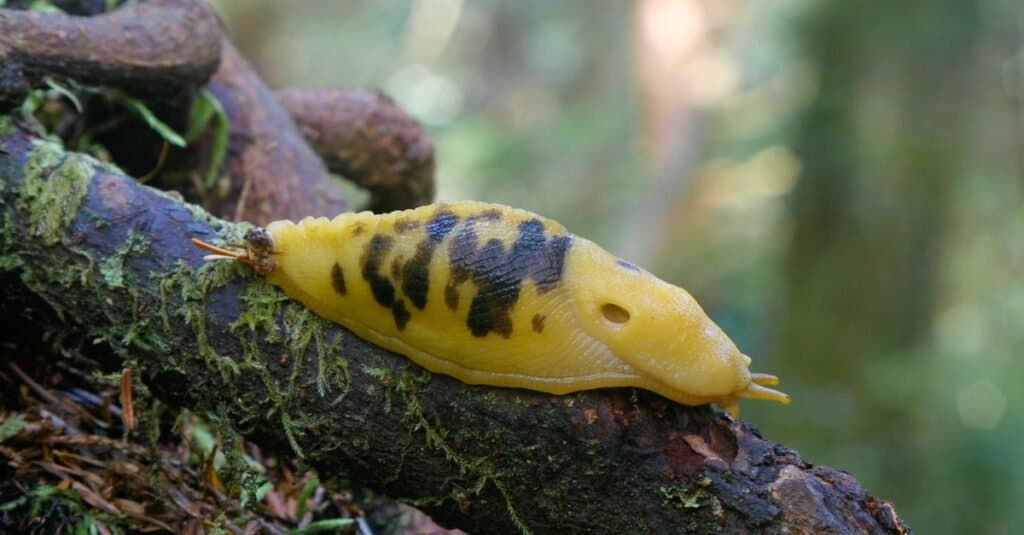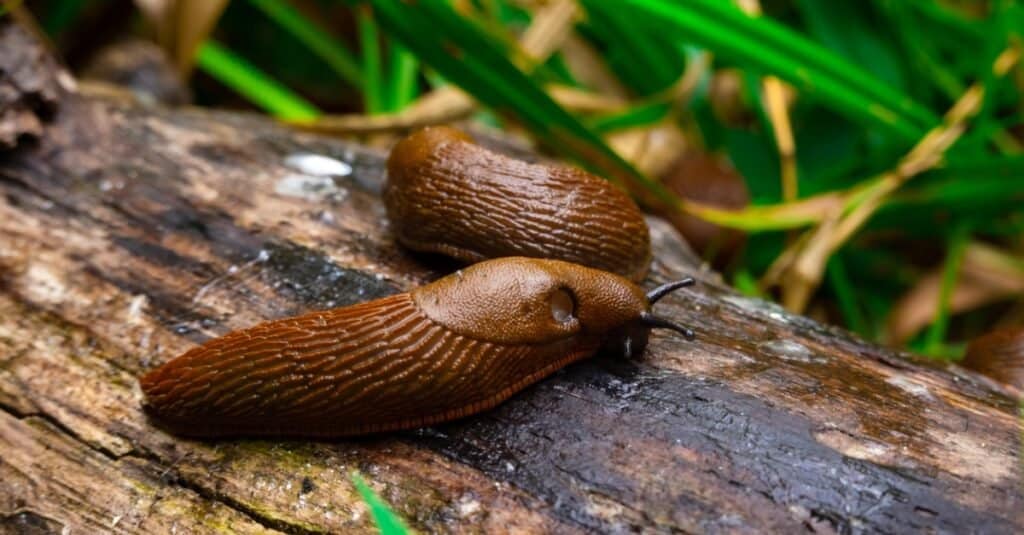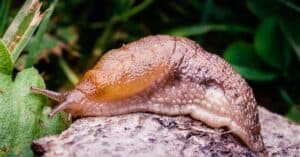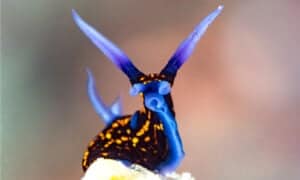Slugs, or “snails without shells,” are unpleasant to look at, and whether you have a green thumb or not, seeing one might make you feel uneasy. Despite their similarities with snails, having no shell definitely makes them look creepier. But are these slow-moving creatures poisonous or dangerous? While slugs are slimy and damaging to plants, they are not poisonous to humans. However, some of them may carry diseases and parasites, such as the rat lungworm, that can be dangerous to other animals and us.
Do Slugs Bite?

Slugs can use their ribbon-like organ to scrape human skin.
©Steffen Foerster/Shutterstock.com
Slugs do not bite in a traditional way. Yet, they use a ribbon-like organ to scrape rocks and other surfaces, which can include human skin. Slug bites are not as dangerous as you would think. Among the few occurrences of slug bites, only some people experienced tingling and pulsation in the bitten area. You cannot call it an actual bite either. Instead, it is simply a scrape on the skin.
Slugs have a radula that creates suction when they drag themselves along the ground. They will cause microscopic damage to your skin if you place your hand in front of their mouth for more than thirty seconds.
It might be a surprise, but slugs have teeth. Their radula has a flexible ring of thousands of microscopic teeth that they use to chew and nibble on their food. They do not intentionally bite humans or pets. And slugs are little critters with weak mouths that can’t seriously leave a mark.
Are Slugs Dangerous to Humans?

Some slugs carry parasites, like lungworm, which can be dangerous to humans.
©Art_Pictures/Shutterstock.com
Slugs are slimy pests that can harm and kill plants, and they can be a real pain for farmers. Slugs also sparked a debate over whether they are dangerous to touch and harm humans. The answer is yes. They might appear to be innocent and touchable, but they carry a variety of parasites. The most common is the rat lungworm or Angiostrongylus cantonensis, and its infection can lead to severe issues. Not all slugs are infected, but some are.
Establishing skin contact with the slug is no worry, but ingesting an infected slug is a different story. If a human ate one of these infectious slugs, the parasites would travel into the brain and spinal cord, causing tissue damage and possibly leading to a type of meningitis called eosinophilic meningitis. While rat lungworm disease is extremely dangerous, most adults experience no or mild symptoms. If you suspect you have this disease, look for indications such as a headache, fever, nausea, and vomiting. It is also critical to keep note of your symptoms days after swallowing a slug. Because of the risk of infection, it is best to seek medical attention immediately.
One unfortunate case involved a 28-year-old Australian man who died after a challenge to eat a slug. After contracting a strand of meningitis, he went into a coma for 420 days. Although most people recover from this disease, he had a severe infection in his brain and died after years of complications.
Are Slugs Poisonous?

Since slugs are naturally non-toxic, they are are not poisonous.
©iStock.com/Ja’Crispy
The belief that slugs are poisonous or toxic has become widespread. An animal is considered poisonous if it causes considerable harm when swallowed, often through the mouth but also through the skin. In this sense, slugs are not poisonous. They don’t release toxins that can harm us if we eat them. It does not, however, imply that eating a slug is risk-free. Since slugs are scavengers, some may carry certain parasites that cause fatal illnesses.
Slugs lack toxin or poison glands, and the slime they create is composed of mucus and serotonin, making them distasteful to predators. In addition, they are mollusks rather than insects, so their exoskeletons do not have any stings either. You will naturally freak out if a slimy pest gets on you. Slugs are carriers of diseases and parasites, yet they are not aggressive towards humans. So, even if you are uncomfortable or scared, it is advisable to remain calm throughout this situation.
Are Slugs Dangerous to Pets?
Generally, slugs aren’t aggressive toward pets, but they can be dangerous when your pet tries to eat them. When threatened or attacked, they make their bodies hard and tightly attached to the substrate. Their mucus makes it harder for predators to keep a tight grip on them. It will also taste unpleasant to ward off predators.
The slimy mucus that slugs create can cause excessive drooling or vomiting in cats and dogs. Although slugs are not poisonous to both, a lungworm parasite can be very harmful. Dogs have a higher possibility of eating slugs. But both will experience behavioral changes, breathing difficulties, coughing, diarrhea, vomiting, and loss of appetite, which are common indications of lungworm infection.
When it comes to birds, slugs are their food source. Birds eat slugs, especially the smaller ones. Because of this, some gardeners use them as natural slug killers. If you have a rabbit as a pet, slugs can’t be harmful to them as well. Rabbits are vegetarians who do not eat slugs on purpose, making them less susceptible to lungworm infection than dogs and cats.
What Attracts Slugs to My House?
Slugs often enter homes seeking warmth, food, or shelter from the elements. Understanding the factors that draw them in can assist in keeping them away. The yellow cellar slug primarily feeds on mold and algae, but it may also consume scraps, pet food, and compost.
This slug species is particularly attracted to dark and moist hiding spots like vents and drains.
Although snails and slugs don’t present any physical harm to humans, they can be quite bothersome when they enter indoor spaces.
Outdoors, have the potential to inflict significant harm to plants in gardens and flowerbeds. These pests create sizable holes in leaves and can even consume entire seedlings.
How to Get Rid of Slugs
Slugs are a natural part of the environment, and they exist to keep the food chain in balance. However, if you can’t stand the sight of these creatures or are simply afraid of the danger they might carry, there are natural ways to get rid of them.
The most common way to remove slugs is to plant more plants that slugs despise. Slugs will avoid your home if you have plants with powerful fragrances like mint, lavender, chives, and spicy herbs. You may also use slug pellets. These are small, poisonous clumps that look like slug food. However, because it includes harmful ingredients, it could hurt our pets if they eat it accidentally.
The photo featured at the top of this post is © Meyta/Shutterstock.com
Thank you for reading! Have some feedback for us? Contact the AZ Animals editorial team.





